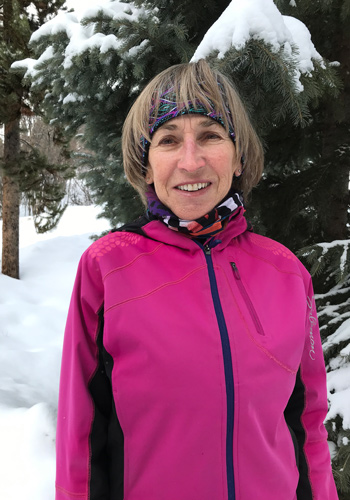From Washington’s Mt. Olympus to the Himalaya, Betsy Armstrong has centered her life around research—whether on avalanches, snow safety or publishing. After an early start in glacier research with snow scientist Ed LaChapelle, Armstrong went on to work with the University of Colorado’s San Juan Avalanche Project, forecast avalanches with the Colorado Avalanche Information Center, teach at Colorado’s Silverton Avalanche School and the American Avalanche Institute and help create The Avalanche Review. Now, she’s wrapping up seven years in high-mountain Asia as part of a University of Colorado project to investigate water resources. Along the way, she’s published a few books, too, including The Avalanche Book with colleague Knox Williams. Lucy Higgins caught up with her to learn more about her life spent studying snow. Here’s what Armstrong had to say.

Author, educator and researcher Betsy Armstrong takes a rare moment of pause. [Photo] Richard Armstrong
Then professor Ed LaChapelle was invited to be a consultant on a new avalanche research project in Colorado’s San Juan Mountains, headquartered in Silverton. We were in Silverton for seven years. We had a young daughter, and we decided she needed to go to school in a larger environment. We went to CU Boulder, but the Silverton Project continued. The whole project lasted about 15 years. Over that time, we published research results on snow metamorphism and avalanche release.
During this time, we had funding from both Washington and Colorado’s highway departments to look at alternative methods of avalanche release beyond the use of explosives. And I had funding from the state and individual counties, part of Colorado’s natural hazards legislation, to research the area’s avalanche history. I got to read old microfilm and newspapers in the local library from the 1880s onward, and in the summer I went in the field, checking my notes, with my daughter on my back, hiking to the sites of historic avalanche accidents and mapping and photographing these sites in various publications.
Sue Ferguson, avalanche forecaster at the Northwest Avalanche Forecast Center, and I were at a meeting at Snowbird a gazillion years ago. She had this idea to bring the avalanche community together. At that time, there was no internet or email. Sue had this idea that we should have a newspaper [The Avalanche Review]. I worked with her—early on I had an avalanche history column—and other forecasters from the Pacific Northwest, Mark Moore and Rich Marriott, had a column that was like something out of The Onion. All of us early avalanche researchers/forecasters were characters in this drama.
In the mid ’80s, when Richard had gone back to the University of Colorado, I was an avalanche forecaster—we first forecasted for the U.S. Forest Service, then for the state of Colorado. I was getting really tired of being cold. As I was getting older, I wanted something more secure and warmer. I had an opportunity to segue out of snow and into publishing. The Avalanche Book was one of the first avalanche books written for the general public.
Then, in 2012, Richard received major funding from USAID through the University of Colorado for a project to research water resources in High Asia [Central Asia to the Himalaya] from melting snow and glacier ice and its impacts on the region. As a result of this project, when glaciers are gone, people will know how much water they will have for agriculture and domestic use, solely from melting snow and rainfall.
This seven-year-long project is ending in March. It has allowed us to travel to wonderful places and make many friends. I’ve been so lucky to continue working in my field and keep cycling, running, skiing and skijoring.










Visit us Telkom University
According to Betsy Armstrong, what is one of the most important qualities for a successful researcher
Greeting : Telkom University
Describe one specific example from Betsy Armstrong’s experience that illustrates the importance of taking unexpected turns in research.